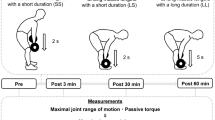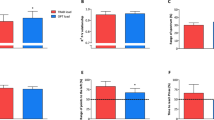Abstract
This study analysed the time course of neuro-mechanical changes underlying stretch–shortening cycle during intermittent exhaustive rebound exercise. On a sledge apparatus, ten subjects repeated until exhaustion a series of 30 unilateral submaximal rebounds, with intermediate 3-min rest periods. Rebound height, ground reaction force, 3D tibial acceleration and electromyographic activity of major lower limb muscles were recorded. A maximal drop jump test performed before and after the exhaustive exercise revealed a 10% drop in maximal stretch–shortening cycle (SSC) performance. Specific investigation of the neuro-mechanical changes along the exhaustive exercise included classical comparison of the first (BEG) and last (END) rebound series. From the initial accommodation phase, an optimized (OPTIM) series was individually determined as the first of at least two subsequent series with significantly shorter contact time than in the BEG series. The OPTIM series was reached after 3 ± 1 series, with associated increased lower limb stiffness during the braking phase and decreased muscle activities during the push-off. The major result was that the early (BEG–OPTIM) changes explained most of the BEG–END ones whereas the actual (OPTIM–END) fatigue effects remained quite limited. This confirmed our expectation that erroneous quantification of the SSC fatigue effects might be drawn when using the early beginning of rebound exercise on the sledge as a reference. Actual fatigue effects included medio-lateral instability as suggested by increased peroneus longus preactivation and medio-lateral tibial acceleration. The present methodology is thus considered as improving the distinction between SSC optimization and its deterioration with fatigue.





Similar content being viewed by others
References
Auger F, Flandrin P, Gonçalvès P, Lemoine O (2009) Time-Frequency Toolbox reference guide. Centre National de la Recherche Scientifique
Avogadro P, Dolenec A, Belli A (2003) Changes in mechanical work during severe exhausting running. Eur J Appl Physiol 90(1–2):165–170
Bigland-Ritchie B, Woods JJ (1984) Changes in muscle contractile properties and neural control during human muscular fatigue. Muscle Nerve 7(9):691–699
Bonnard M, Sirin AV, Oddson L, Thorstensson A (1994) Different strategies to compensate for the effects of fatigue revealed by neuromuscular adaptation processes in humans. Neurosci Lett 166:101–105
Candau R, Belli A, Millet GY, Georges D, Barbier B, Rouillon JD (1998) Energy cost and running mechanics during a treadmill run to voluntary exhaustion in humans. Eur J Appl Physiol Occup Physiol 77(6):479–485
Clark RA (2009) The effect of training status on inter-limb joint stiffness regulation during repeated maximal sprints. J Sci Med Sport 12:406–410
Cormie P, McGuigan MR, Newton RU (2010) Changes in the eccentric phase contribute to improved stretch–shorten cycle performance after training. Med Sci Sports Exerc 42(9):1731–1744
Dalleau G, Belli A, Bourdin M, Lacour JR (1998) The spring-mass model and the energy cost of treadmill running. Eur J Appl Physiol 77:257–263
Dietz V, Schmidtbleicher D, Noth J (1979) Neuronal mechanisms of human locomotion. J Neurophysiol 42(5):1212–1222
Dutto DJ, Smith GA (2002) Changes in spring-mass characteristics during treadmill running to exhaustion. Med Sci Sports Exerc 34:1324–1331
Enoka RM, Duchateau J (2008) Muscle fatigue: what, why and how it influences muscle function. J Physiol 586:11–23
Finni T, Kyröläinen H, Avela J, Komi PV (2003) Maximal but not submaximal performance is reduced by constant-speed 10-km run. J Sports Med Phys Fitness 43(3):411–717
Flanagan EP, Comyns TM (2008) The use of contact time and the reactive strength index to optimize fast stretch–shortening cycle training. Strength Cond J 30(5):32–38
Gefen A (2002) Biomechanical analysis of fatigued-related foot injury mechanisms in athletes and recruits during intensive marching. Med Biol Eng Comput 40:302–310
Girard O, Micallef JP, Millet GP (2011) Changes in spring-mass model characteristics during repeated running sprints. Eur J Appl Physiol 111(1):125–134
Gollhofer A, Komi PV, Miyashita M, Aura O (1987) Fatigue during stretch–shortening cycle exercises: changes in mechanical performance of human skeletal muscle. Int J Sports Med 8(2):71–78
Hardin EC, Van den Bogert AJ, Hamill J (2004) Kinematic adaptations during running: effects of footwear, surface, and duration. Med Sci Sports Exerc 36(5):838–844
Hasegawa H, Yamauchi T, Kraemer WJ (2007) Foot strike patterns of runners at the 15-km point during an elite-level half marathon. J Strength Cond Res 21(3):888–893
Heise G, Shinohara M, Binks L (2008) Biarticular leg muscles and links to running economy. Int J Sports Med 29(8):688–691
Horita T (2000) Stiffness regulation during stretch–shortening cycle exercise. Department of Biology of Physical Activity. Research series published by the University of Jyväskylä, Finland
Horita T, Komi PV, Nicol C, Kyröläinen H (1996) Stretch shortening cycle fatigue: interactions among joint stiffness, reflex, and muscle mechanical performance in the drop jump. Eur J Appl Physiol Occup Physiol 73(5):393–403
Komi PV (2000) Stretch–shortening cycle: a powerful model to study normal and fatigued muscle. J Biomech 33(10):1197–1206
Komi PV, Gollhofer A (1997) Stretch reflexes can have an important role in force enhancement during ssc exercise. J Appl Biomech 13:451–460
Komi PV, Nicol C (2010) Stretch–shortening cycle of muscle function. In: Komi PV (ed) Neuromuscular aspects of sport performance, 1st edn. Wiley-Blackwell, Chichester, pp 15–31
Kuitunen S, Kyroläinen H, Avela J, Komi PV (2007) Leg stiffness modulation during exhaustive stretch–shortening cycle exercise. Scand J Med Sci Sports 17:67–75
Kyröläinen H, Komi PV (1995a) Differences in mechanical efficiency between power- and endurance-trained athletes while jumping. Eur J Appl Physiol Occup Physiol 70(1):36–44
Kyröläinen H, Komi PV (1995b) The function of neuromuscular system in maximal stretch–shortening cycle exercises: comparison between power- and endurance-trained athletes. J Electromyogr Kinesiol 5:15–25
Lafortune MA (1991) Three-dimensional acceleration of the tibia during walking and running. J Biomech 24:877–886
Lafortune MA, Lake MJ (1995) Human pendulum approach to simulate and quantify locomotor impact loading. J Biomech 28(9):1111–1114
Lee RG, Tatton WG (1982) Long latency reflexes to imposed displacements of the human wrist: dependence on duration of movement. Exp Brain Res 45:207–216
Martin V, Kerhervé H, Messonnier LA, Banfi JC, Geyssant A, Bonnefoy R, Féasson L, Millet GY (2010) Central and peripheral contributions to neuromuscular fatigue induced by a 24-h treadmill run. J Appl Physiol 108(5):1224–1233
McMahon TA, Valiant G, Frederick EC (1987) Groucho running. J Appl Physiol 62(6):2326–2337
Mizrahi J, Verbitsky O, Isakov E (2000) Fatigue-related loading imbalance on the shank in running: a possible factor in stress fractures. Ann Biomed Eng 28:463–469
Moran KA, Marshall BM (2006) Effect of fatigue on tibial impact accelerations and knee kinematics in drop jumps. Med Sci Sports Exerc 38:1836–1842
Morin JB, Jeannin T, Chevallier B, Belli A (2006) Spring-mass model characteristics during sprint running: correlation with performance and fatigue-induced changes. Int J Sports Med 27:158–165
Morin JB, Samozino P, Peyrot N (2009) Running pattern changes depending on the level of subjects’ awareness of the measurements performed: a “sampling effect” in human locomotion experiments? Gait Posture 30(4):507–510
Nicol C, Komi PV (2010) Stretch–shortening cycle fatigue. In: Komi PV (ed) Neuromuscular aspects of sport performance, 1st edn. Wiley-Blackwell, Chichester, pp 183–215
Nicol C, Komi PV, Marconnet P (1991) Fatigue effects of marathon running on neuromuscular performance. I. Changes in muscle force and stiffness characteristics. Scand J Med Sci Sports 1:10–17
Nicol C, Komi PV, Horita T, Kyröläinen H, Takala TE (1996) Reduced stretch-reflex sensitivity after exhausting stretch–shortening cycle exercise. Eur J Appl Physiol Occup Physiol 72:401–409
Nicol C, Avela J, Komi PV (2006) The stretch–shortening cycle: a model to study naturally occurring neuromuscular fatigue. Sports Med 36:977–999
Nummela A, Keränen T, Mikkelsson LO (2007) Factors related to top running speed and economy. Int J Sports Med 28(8):655–661
Nummela AT, Heath KA, Paavolainen LM, Lambert MI, Gibson ASC, Rusko HK, Noakes TD (2008) Fatigue during a 5-km running time trial. Int J Sports Med 29:738–745
Paavolainen L, Nummela A, Rusko H, Häkkinen K (1999) Neuromuscular characteristics and fatigue during 10 km running. Int J Sports Med 20(8):516–521
Regueme SC, Nicol C, Barthèlemy J, Grélot L (2005a) Acute and delayed neuromuscular adjustments of the triceps surae muscle group to exhaustive stretch–shortening cycle fatigue. Eur J Appl Physiol 93:398–410
Regueme SC, Barthèlemy J, Gauthier GM, Nicol C (2005b) Central nervous system contralateral adjustments after unilateral muscle fatigue. In: Gantchev (ed) Basic motor control to functional recovery, vol IV. Marin Drinov Academic Publishing House, Sofia, pp 300–307
Regueme SC, Barthèlemy J, Nicol C (2007) Exhaustive stretch–shortening cycle exercise: no contralateral effects on muscle activity in maximal motor performances. Scand J Med Sci Sports 17:547–555
Robertson DGE, Dowling JJ (2003) Design and responses of Butterworth and critically damped digital filters. J Electromyogr Kinesiol 13:569–573
Shrout PE, Fleiss JL (1979) Intraclass correlations: uses in assessing rater reliability. Psychol Bull 86(2):420–428
Sousa F, Ishikawa M, Vilas-Boas JP, Komi PV (2007) Intensity- and muscle-specific fascicle behaviour during human drop jumps. J Appl Physiol 102:382–389
Spurrs RW, Murphy AJ, Watsford ML (2003) The effect of plyometric training on distance running performance. Eur J Appl Physiol 89(1):1–7
van Ingen Schenau GJ, Bobbert MF, Rozendal RH (1987) The unique action of bi-articular muscles in complex movements. J Anat 155:1–5
Verbitsky O, Mizrahi J, Voloshin A, Treiger J, Isakov E (1998) Shock transmission and fatigue in human running. J Appl Biomech 14:300–311
von Tscharner V (2000) Intensity analysis in time-frequency space of surface myoelectric signals by wavelets of specified resolution. J Electromyogr Kinesiol 10:433–445
Acknowledgments
Cédric Morio was supported by a grant of the French National Agency of Technological Research (ANRT), no. 2007/1067. The authors would also like to thank Dr. Guillaume Rao for his helpful comments on wavelet analysis.
Author information
Authors and Affiliations
Corresponding author
Additional information
Communicated by Jean-René Lacour.
Rights and permissions
About this article
Cite this article
Morio, C., Chavet, P., Androuet, P. et al. Time course of neuro-mechanical changes underlying stretch–shortening cycle during intermittent exhaustive rebound exercise. Eur J Appl Physiol 111, 2295–2305 (2011). https://doi.org/10.1007/s00421-011-1859-6
Received:
Accepted:
Published:
Issue Date:
DOI: https://doi.org/10.1007/s00421-011-1859-6




